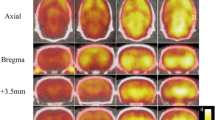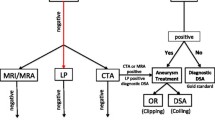Summary
26 patients with subarachnoid haemorrhage (SAH) were investigated with 68-Ga-EDTA and positron emission tomography (PET) in order to evaluate the presence of a blood brain barrier (BBB) disturbance. Only one patient showed a BBB disruption. It is suggested that increased levels of substances with higher molecular weight than 68-Ga-EDTA in the cerebrospinal fluid (CSF) are the result of a change in the metabolism of the CSF and the brain tissue caused by a SAH.
Similar content being viewed by others
References
Davis JM, Davis KR, Crowell RM (1980) Subarachnoid haemorrhage secondary to ruptured intracranial aneurysm: Prognostic significance of cranial CT. AJR 134: 711–715
Dozci T, Ambrose J, O'Laoire S (1984) Significance of contrast enhancement in cranial computerized tomography after subarachnoid hemorrhage. J Neurosurg 60: 335–342
Ekbom K, Greitz T (1970) Carotid angiography in cluster headache. Acta Radiol (Diagn) 10: 177–187
Ericson K, Bergström M, Eriksson L, Hatam A, Greitz T, Söderström CE, Widen L (1981) Positron emission tomography with 68-Ga-EDTA compared with transmission computed tomography in the evaluated of brain infarcts. Acta Radiol (Diagn) 22: 385–398
Gabrielson T, Greitz T (1970) Normal size of internal carotid, middle and anterior cerebral arteries. Acta Radiol (Diagn) 10: 1–10
von Holst H, Lindquist C, Sedvall G (1985) Increased concentrations of the monoamines metabolites HVA, 5-HIAA in lumbar and central CSF and of MOPEG in lumbar CSF after subarachnoid hemorrhage. Acta Neurochir (Wien) 77: 146–151
von Holst H, Sollevi A (1985) Increased concentration of hypoxanthine in human central cerebrospinal fluid after subarachnoid hemorrhage. Acta Neurochir (Wien) 77: 52–59
von Holst H, Hagenfeldt L (1985) Increased concentration of aminoacids in human lumbar and central cerebrospinal fluid after subarachnoid hemorrhage. Acta Neurochir (Wien) 78: 46–56
von Holst H, Sara V (1985) Increased levels of somatomedins in human lumbar and central cerebrospinal fluid after subarachnoid hemorrhage. Acta Neurochir (Wien) 78: 157–169
von Holst H, Ericson K (1988) Bilateral angiographic vasoconstriction of the middle cerebral and internal carotid arteries after subarachnoid hemorrhage in patients with and without aneurysms. A retrospective study. Acta Neurochir (Wien) 94: 32–37
von Holst H, Ericson K, Haberbech M, Steiner L (1988) Angiographic investigation of cerebral vasospasm in subarachnoid hemorrhage due to arteriovenous malformation. Acta Neurochir (Wien) 94: 129–132
Hunt WE, Hess RM (1976) Surgical risk as related to time of intervention in the repair of intracranial aneurysms. J Neurosurg 28: 14–19
Inoue Y, Saiwai S, Miyamoto T, Ban S, Yamamoto T, Takemoto K, Taniguchi K, Sato S, Namba K, Ogata M (1981) Postcontrast computed tomography in subarachnoid hemorrhage from ruptured aneurysms. J Comput Assist Tomogr 5: 341–344
Kingsley DPE, Kendall BE, Greitz T, Hoare RD (1979) Extravasation of contrast-enhanced blood into the subarachnoid space during computed tomography. Neuroradiology 18: 259–262
Litton J, Bergström M, Eriksson J, Bohm C, Blomqvist G, Kesselberg M (1984) Performance study of the PC-384 positron camera system for emission tomography of the brain. J Comput Assist Tomogr 8 (1): 74–87
McComb JG (1983) Recent research into the nature of cerebrospinal formation and absorption. J Neurosurg 59: 369–383
Milhorat TH, Hammock MR (1983) Cerebrospinal fluid as reflection of internal milieu of brain. In: Wood JH (ed) Neurobiology of cerebrospinal fluid 2. Plenum Press, New York, pp 1–22
Moran CJ, Naidich TP, Gado MH, Holloman WG, Shalen PM (1978) Leptomeningeal findings in CT of subarachnoid hemorrhage. J Comput Assist Tomogr 2: 520
Mosskin M, von Holst H, Ericson K, Noren G (1986) The blood tumour barrier in intracranial tumours studied with computed tomography and positron emission tomography using 68-Ga-EDTA. Neuroradiology 28: 259–263
Tasawa T, Mizukami M, Kawase T, Usami T, Togashi O, Hyodo A, Eguchi T (1983) Relationship between contrast enhancement on computed tomography and cerebral vasospasm in patients with subarachnoid hemorrhage. Neurosurgery 12 (6): 643–648
Wood JH (1980) Physiology, pharmacology and dynamics of cerebrospinal fluid. In: Wood JH (ed) Neurobiology of cerebrospinal fluid 1. Plenum Press, New York, pp 1–16
Author information
Authors and Affiliations
Rights and permissions
About this article
Cite this article
von Holst, H., Ericson, K. & Edner, G. Positron emission tomography with 68-Ga-EDTA and computed tomography in patients with subarachnoid haemorrhage. Acta neurochir 97, 146–149 (1989). https://doi.org/10.1007/BF01772827
Issue Date:
DOI: https://doi.org/10.1007/BF01772827




